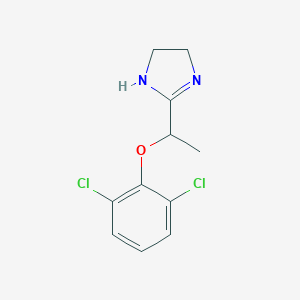Search for drugs:
Typing the drug name to query
LOFEXIDINE HYDROCHLORIDE
DIR Classification
Classification:Moderate-DIQT concern
Severity Score:3.0
Description in Drug Labeling: View Full Labeling: SPL in DailyMed | PDF
- WARNINGS AND PRECAUTIONS
- Risk of QT Prolongation
- LUCEMYRA prolongs the QT interval.
- Avoid using LUCEMYRA in patients with congenital long QT syndrome.
- Monitor ECG in patients with congestive heart failure, bradyarrhythmias, hepatic impairment, renal impairment, or patients taking other medicinal products that lead to QT prolongation (e.g., methadone). In patients with electrolyte abnormalities (e.g., hypokalemia or hypomagnesemia), correct these abnormalities first, and monitor ECG upon initiation of LUCEMYRA [see DOSING AND ADMINISTRATION (2.1), ADVERSE REACTIONS (6.1), SPECIAL POPULATIONS (8.6)(8.7), CLINICAL PHARMACOLOGY (12.2)].
- DRUG INTERACTIONS
- Methadone
- LUCEMYRA and methadone both prolong the QT interval. ECG monitoring is recommended in patients receiving methadone and LUCEMYRA [see WARNINGS AND PRECAUTIONS (5.2), CLINICAL PHARMACOLOGY (12.3)].
- ADVERSE REACTIONS
- Postmarketing Experience
- Lofexidine is marketed in other countries for relief of opioid withdrawal symptoms. The following events have been identified during postmarketing use of lofexidine. Because these reactions are reported voluntarily from a population of uncertain size, it is not always possible to reliably estimate their frequency or establish a causal relationship to drug exposure.
- Since lofexidine's initial market introduction in 1992, the most frequently reported postmarketing adverse event with lofexidine has been hypotension [see WARNINGS AND PRECAUTIONS (5.1)]. There has been one report of QT prolongation, bradycardia, torsades de pointes, and cardiac arrest with successful resuscitation in a patient that received lofexidine and three reports of clinically significant QT prolongation in subjects concurrently receiving methadone with lofexidine.
- CLINICAL PHARMACOLOGY
- Pharmacodynamics
- Cardiac Electrophysiology
- Single LUCEMYRA doses of 1.44 to 1.8 mg produced maximum mean change from baseline in QTcF (ΔQTcF) of 14.4 msec (upper two-sided 90% CI: 22.3 msec) and 13.6 msec (17.4 msec) for 1.44 and 1.8 mg respectively in healthy normal volunteers.
- In a Phase 3 placebo-controlled, dose response study in opioid dependent subjects, LUCEMYRA was associated with a maximum mean prolongation of the QTcF interval 7.3 (8.8) and 9.3 (10.9) msec at doses of 2.16 and 2.88 mg/day, respectively.
- Patients with hepatic impairment
- Administration of LUCEMYRA to subjects with hepatic impairment was associated with prolongation of the QTc interval, which was more pronounced in subjects with severe hepatic impairment [see USE IN SPECIFIC POPULATIONS (8.6)].
- Patients with renal impairment
- Administration of LUCEMYRA to subjects with renal impairment was associated with prolongation of the QTc interval, which was more pronounced in subjects with severe renal impairment [see USE IN SPECIFIC POPULATIONS (8.7)]
- LUCEMYRA coadministered with methadone
- LUCEMYRA (2.88 mg/day) coadministered with methadone in 18 methadone-maintained patients (80-120 mg/day) resulted in a maximum mean increase from methadone-alone baseline in QTcF of 9.1 (14.2) msec.
- LUCEMYRA coadministered with buprenorphine
- LUCEMYRA (2.88 mg/day) coadministered with buprenorphine in 21 buprenorphine-maintained patients (16-24 mg/day) resulted in a maximum mean QTcF increase in QTcF of 15 (5.6) msec compared to a buprenorphine-alone baseline.
- PATIENT PACKAGE INSERT
- Before taking LUCEMYRA, tell your healthcare provider about all of your medical conditions, including if you:
- have low blood pressure
- have a slow heart rate
- have any heart problems, including history of heart attack or a condition called long QT syndrome
- have liver or kidney problems
- drink alcohol
- are pregnant or plan to become pregnant. It is not known if LUCEMYRA can harm your unborn baby.
- are breastfeeding or plan to breastfeed. It is not known if LUCEMYRA passes into your breast milk. Talk to your healthcare provider about the best way to feed your baby during treatment with LUCEMYRA.
- USE IN SPECIFIC POPULATIONS
- Hepatic Impairment
- Clinically relevant QT prolongation may occur in subjects with hepatic impairment [see WARNINGS AND PRECAUTIONS (5.2), CLINICAL PHARMACOLOGY (12.2)].
- [Renal Impairment]
- Clinically relevant QT prolongation may occur in subjects with renal impairment [see WARNINGS AND PRECAUTIONS (5.2), CLINICAL PHARMACOLOGY (12.2)].
Postmarketing Surveillance
Contingency Table:
Current Drug
Other Drugs
QT Prolongation
0
24092
Other ADRs
355
38381232
Odds Ratio = 0.0
Drug Property Information
ATC Code(s):
- N07BC04 - lofexidine hydrochloride
- N07BC - Drugs used in opioid dependence
- N07B - DRUGS USED IN ADDICTIVE DISORDERS
- N07 - OTHER NERVOUS SYSTEM DRUGS
- N - NERVOUS SYSTEM
Active Ingredient:LOFEXIDINE HYDROCHLORIDE
Active Ingredient UNII:V47G1SDI1B
Drugbank ID:DB04948
PubChem Compound:30668
CTD ID:C025655
PharmGKB:PA164744510
CAS Number:31036-80-3
Dosage Form(s):tablet, film coated
Route(s) Of Administrator:oral
Daily Dose:
- 1.4 mg/day N07BC04
Chemical Structure: 

SMILE Code:
CC(OC1=C(Cl)C=CC=C1Cl)C1=NCCN1
CC(OC1=C(Cl)C=CC=C1Cl)C1=NCCN1
Reference
N/A
Disclaimer:
The content of this database of QT prolongation is intended for educational and scientific research purposes only. It is not intended as a substitute for professional medical advice, diagnosis or treatment.
Any mention of commercial products is for clarification and not intended as endorsement.